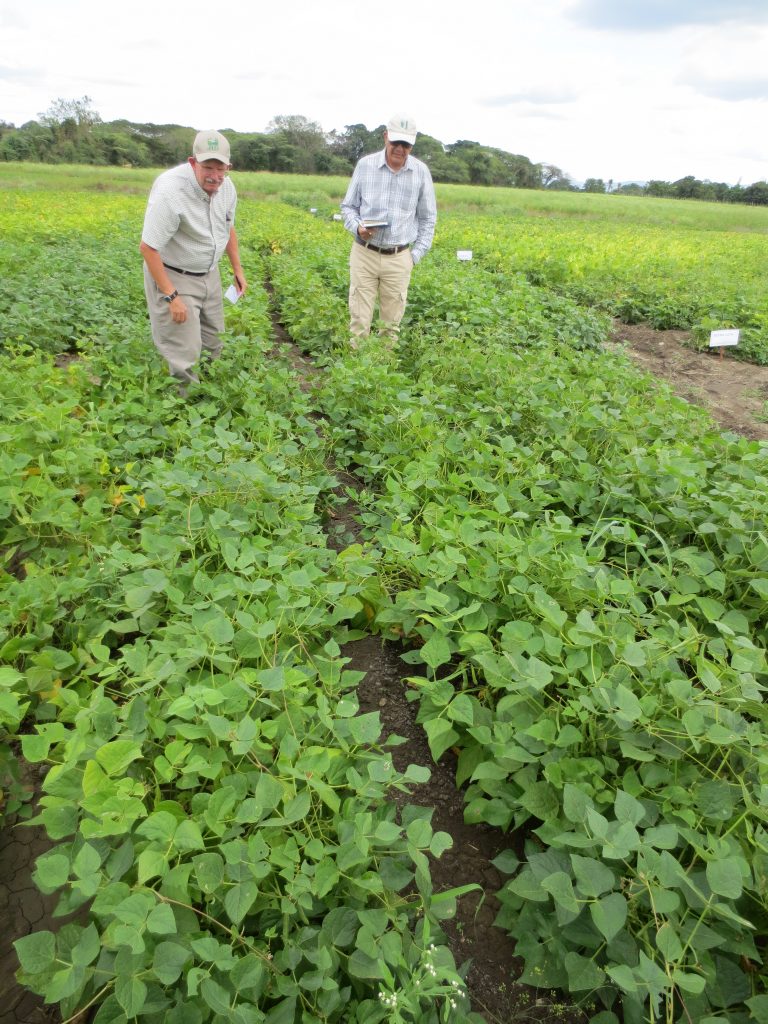From 6/12 to 6/16/2019, advanced trials of lines from three generations of PIC (Phaseolus improvement cooperative) populations under consideration for release were evaluated at the Selian Station of the Tanzanian Agriculture Research Institute (TARI) and in on-farm trials in Arusha, and at the Uyole Station of TARI in Mbeya in collaboration with Drs. Susan Nchimbi and Luseko Chilagane of Sokoine University of Agriculture.
Due to initial and extended drought, the stands in the trial at Selian (Arusha) were affected and the planting was delayed, but plant stand and vigor data were collected. There was little disease pressure at the site. Superior Phaseolus Improvement Cooperative (PIC) lines (32 total) were evaluated in a combined trial and superior lines from two generations of selection included R11-7, 15 TZ MBY PIC 035-Row2, 15 TZ MBY PIC 038-Row4, and 15 TZ MBY PIC 040-Row1. ADP-447 (Yunguilla) and ADP-190 (Baetao Manteiga) showed superior vigor and yield potential in increases next to the trials. Mr. Alex Kisamo commented that he is impressed with ADP-447 for production in Tanzania. A subset of the DDP (with 8 entries) and a new pinto bean trial (with 59 entries) showed promise in comparison to the local pinto check.

Arusha Selian Station photos from left to right: Drs. Nchimbi, Chilagane, and Alex Kisamo (left); increases of ADP-447 (middle); and ADP-190 (right).
On 6/13 we travelled to three villages in the Kilimanjaro area near Arusha, Sakila, Kwanangasha, and Nasholi, with two extension agents. Soils at all three sites appeared to be composed of dark volcanic soils. Visual ratings based on vigor and stand were completed on a superior set of 18 PIC lines from those indicated above and on the 8 DDP pinto lines at the three villages in two replications. The Sakila site was likely 250m higher than the other two sites and it was noted that this trial had received additional rainfall and weed pressure. The farmer at this site plants yellow beans. The Kwanangasha site had higher weed pressure in the 2nd replication. The farmer had dedicated part of her field to green gram for home consumption. The final trial, Nasholi, was far superior than the others in terms of plant stand and vigor, and it appears the trial had better weed control and had been fertilized. There will be farmer evaluation data collected near harvest maturity and yield data obtained as well in these three trials.

Photos from left to right of on-farm trials in villages in Arusha area: Dr. Nchimbi, two extension agents, and farmer at his farm in Sakila village (left); trials at Kwanangasha village (middle); and trials at the Nasholi village (right).
On 6/14 we travelled to the Mbeya site in the Southern highlands of Tanzania and on 6/15 Dr. Nchimbi and I met Michael Kilango at the Uyole Station in Mbeya for data collection. We were impressed with the good stands, vigorous plant growth, and advanced stage of the trials. These trials were planted 2-3 weeks earlier than the Arusha trials. The trials were also fertilized with urea at the flowering stage—unlike most of the other trials (except for the Nasholi trial). We collected ALS, rust (for some trials), overall agronomic performance, and in some cases plant stand data. Michael Kilango noted that farmers passing by the fields were interested by the ADP-447 increase and that some had requested seed of this line. PIC lines performing well in Arusha also performed well in Mbeya for the most part. Pinto performance was superior in Mbeya with some lines showing good adaptation, yield potential and disease resistance. A subset (20 RILs) from the CAL 143/Rojo RIL population (3 reps) and 158 RILS from the Bukoba/Kijivu RIL population (1 rep) were evaluated for ALS. The Iwanga village on-farm trial, in the Mbeya area, will be visited by collaborators for agronomic and farmer participatory evaluations.

Mbeya Uyole trials (left photo); rust (pictured) and angular leaf spot (ALS) symptoms present (middle), superior pinto with early maturity and adaptation (right).
The visit was effective in the selection of PIC lines for potential release in Tanzania and in the U.S. We plan to initiate the process for the release of ADP-447 and ADP-190 in Tanzania. The PIC performance between Mbeya and Arusha was remarkably consistent, with ADP-447, ADP-190, R11-7, 15 TZ MBY PIC 035-Row2, 15 TZ MBY PIC 038-Row4, and 15 TZ MBY PIC 040-Row1 continuing to perform well and being considered for release.

